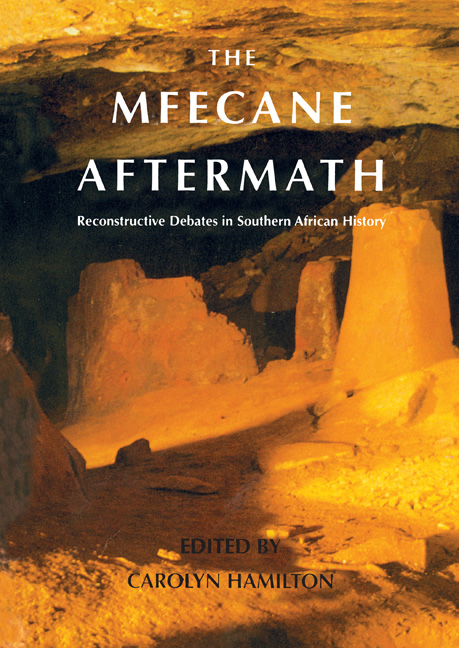Book contents
- Frontmatter
- Contents
- Maps
- Preface
- Acknowledgements
- Notes on Orthography and Names
- Contributors
- Introduction
- Part One Historiography and Methodology
- Part Two The South-Eastern Coastal Region
- Beyond the Concept of the ‘Zulu Explosion’ Comments on the Current Debate
- 5 Sources of Conflict in Southern Africa c. 1800-1830: The ‘Mfecane’ Reconsidered
- 6 Political Transformations in the Thukela-Mzimkhulu Region in the Late Eighteenth and Early Nineteenth Centuries
- 7 The Character and Objects of Chaka’: A Reconsideration of the Making of Shaka as Mfecane Motor
- 8 Matiwane's Road to Mbholompo: A Reprieve for the Mfecane?
- 9 Unmasking the Fingo: The War of 1835 Revisited
- 10 The Mfecane Survives its Critics
- Part Three The Interior
- Glossary
- Abbreviations
- Bibliographer's Note
- Bibliography
- Complete List of Papers Presented at the Colloquium
- Index
7 - The Character and Objects of Chaka’: A Reconsideration of the Making of Shaka as Mfecane Motor
from Part Two - The South-Eastern Coastal Region
Published online by Cambridge University Press: 31 May 2019
- Frontmatter
- Contents
- Maps
- Preface
- Acknowledgements
- Notes on Orthography and Names
- Contributors
- Introduction
- Part One Historiography and Methodology
- Part Two The South-Eastern Coastal Region
- Beyond the Concept of the ‘Zulu Explosion’ Comments on the Current Debate
- 5 Sources of Conflict in Southern Africa c. 1800-1830: The ‘Mfecane’ Reconsidered
- 6 Political Transformations in the Thukela-Mzimkhulu Region in the Late Eighteenth and Early Nineteenth Centuries
- 7 The Character and Objects of Chaka’: A Reconsideration of the Making of Shaka as Mfecane Motor
- 8 Matiwane's Road to Mbholompo: A Reprieve for the Mfecane?
- 9 Unmasking the Fingo: The War of 1835 Revisited
- 10 The Mfecane Survives its Critics
- Part Three The Interior
- Glossary
- Abbreviations
- Bibliographer's Note
- Bibliography
- Complete List of Papers Presented at the Colloquium
- Index
Summary
In a series of papers and articles beginning in 1983, Julian Cobbing has offered a radical, and often provocative, critique of the mfecane as the pivotal concept of the history of southern Africa in the nineteenth century. He asks vigorous new questions about everything from the identity of the ‘Fingoes’ in the south and the ‘Mantatee hordes’ on the highveld, to the extent of the slave trade around Delagoa Bay. Cobbing's work has stimulated a host of graduate studies on these topics, and has prompted a number of established students of the period to reassess aspects of their earlier work. The sheer scope of the critique is, however, also the source of its greatest weakness. In particular, Cobbing may be criticised for misusing evidence and employing imprecise periodisation.
Nowhere are these criticisms more pertinent than in relation to a central element of Cobbing's thesis, namely, his view of ‘Shaka-the-monster’ as a European invention to mask illegal labour procurement activities and land occupation. In this essay, I focus on Cobbing's reconstruction of the making of the Shaka myth. My purpose is to disentangle the elaborate weave of Cobbing's powerful insights and implausible conspiracy theories. I suggest that while Cobbing's critique is extremely valuable, especially in the way that it forces historians to question many of the assumptions with which they have for too long been extremely comfortable, he fails fundamentally to come to grips with the full complexity of his primary target, past historical myth-making processes.
Cobbing identifies four key elements in the notion of the mfecane as most commonly espoused: firstly, ‘a self-generated internal revolution’ within northern Nguni-speaking societies which culminated in the 1820s in the regionally dominant Zulu power led by a savage despot, Shaka; secondly, attacks by the Zulu on neighbouring chiefdoms which forced the latter to flee their land and which, in turn, displaced other chiefdoms still further afield; thirdly, a ‘cataclysmic period of black-on-black destruction’ (including cannibalism) leading to the depopulation of the interior of South Africa; with all of this culminating, fourthly, in the restoration of security with the advent of the Europeans. Cobbing's observation that this explanation of the depeopling of much of the interior and for the arrangement of the African inhabitants of southern Africa in a surrounding ‘horseshoe’ serves to legitimate white occupation of the land and the ideology of separate development is not new.
- Type
- Chapter
- Information
- Mfecane AftermathReconstructive Debates in Southern African History, pp. 183 - 212Publisher: Wits University PressPrint publication year: 1995



